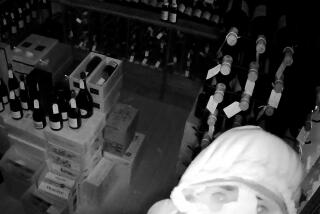What Kind of Wine Goes With Slim Jim?
- Share via
DALLAS — Along with soft drinks, prepaid phone cards, six packs of beer and gasoline, Southland Corp. has recently started aggressively promoting wine in its 7-Eleven convenience stores.
The 3,200 7-Eleven units in the United States allowed to carry wines under local liquor ordinances now stock up to 30 different kinds of varietal and premium brands, at prices ranging from $5.99 to $14.99 a bottle, said Dennis Phelps, the retailer’s category manager for beer and wine.
He declined to say how much revenue Southland currently derives from convenience-store wine sales. But according to Wine Business Insider, a weekly industry trade publication based in Sonoma, Calif., 7-Eleven’s annual U.S. wine sales are nearly $50 million, and Southland is hoping the new marketing effort will triple that figure over the next five years.
Wines from producers such as Beringer, Fetzer, Gallo, Kendall Jackson and Turning Leaf are now displayed on a special rack inside 7-Eleven stores. The displays also feature accessories such as corkscrews and gift bags, the most current issue of Wine Spectator and a wine-of-the-month selection.
U.S. 7-Elevens previously offered only a limited selection of mostly generic wines.
“This is a watershed development in the marketing of wine to American consumers,” said David Ross, managing editor of Market Watch magazine, a New York trade publication that follows the U.S. liquor and wine-retailing industry, estimated at $96 billion annually by Impact Databank.
“They’re not just throwing wine on the shelf. They are making a statement through the display,” he said.
Market Watch, Impact Databank and the consumer wine magazine offered in the new 7-Eleven displays are all owned by the same company.
Sales of varietal and premium wines in 7-Eleven stores will help change the drink’s image from upscale and snobby to one that is more accessible and comfortable for American consumers, Ross predicted.
“This is bringing wine to the masses,” agreed Cyril Penn, editor of Wine Business Insider.
Phelps said Southland finds the demographics of wine consumption appealing because consumers tend to drink more wine and less beer as they age.
Market Watch’s Ross estimated that 7-Eleven’s combined beer and wine sales in 1998 will be between $600 million and $700 million.
7-Eleven stores average roughly 1,200 customers a day.
Industry observers say Southland’s sales volume presents a competitive challenge and may alter the wine-retailing landscape.
“Potentially, 7-Eleven could have a big impact on wine retailing,” said John Gillespie, president of the Wine Market Council, an industry trade organization based in Larkspur, Calif.
Still, Southland faces a marketing challenge because of the gap between consumers’ perception of convenience stores and the highbrow image of wine.
As Ross put it, “You wouldn’t normally associate 7-Eleven with a fine-wine destination stop.”
More to Read
Eat your way across L.A.
Get our weekly Tasting Notes newsletter for reviews, news and more.
You may occasionally receive promotional content from the Los Angeles Times.








